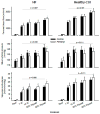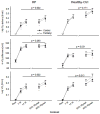Group III/IV muscle afferents impair limb blood in patients with chronic heart failure
- PMID: 24794967
- PMCID: PMC4075285
- DOI: 10.1016/j.ijcard.2014.04.157
Group III/IV muscle afferents impair limb blood in patients with chronic heart failure
Abstract
Objective: To better understand the hemodynamic and autonomic reflex abnormalities in heart-failure patients (HF), we investigated the influence of group III/IV muscle afferents on their cardiovascular response to rhythmic exercise.
Methods: Nine HF-patients (NYHA class-II, mean left ventricular ejection-fraction: 27 ± 3%) performed single leg knee-extensor exercise (25/50/80% peak-workload) under control conditions and with lumbar intrathecal fentanyl impairing μ-opioid receptor-sensitive muscle afferents.
Results: Cardiac-output (Q) and femoral blood-flow (QL) were determined, and arterial/venous blood samples collected at each workload. Exercise-induced fatigue was estimated via pre/post-exercise changes in quadriceps strength. There were no hemodynamic differences between conditions at rest. During exercise, Q was 8-13% lower with Fentanyl-blockade, secondary to significant reductions in stroke volume and heart rate. Lower norepinephrine spillover during exercise with Fentanyl revealed an attenuated sympathetic outflow that likely contributed to the 25% increase in leg vascular conductance (p<0.05). Despite a concomitant 4% reduction in blood pressure, QL was 10-14% higher and end-exercise fatigue attenuated by 30% with Fentanyl-blockade (p<0.05).
Conclusion/practice/implications: Although group III/IV muscle afferents play a critical role for central hemodynamics in HF-patients, it also appears that these sensory neurons cause excessive sympatho-excitation impairing QL which likely contributes to the exercise intolerance in this population.
Keywords: Autonomic control; Circulation; Exercise pressor reflex; Sensory neurons.
Copyright © 2014 Elsevier Ireland Ltd. All rights reserved.
Figures




References
-
- Adreani CM, Hill JM, Kaufman MP. Responses of group iii and iv muscle afferents to dynamic exercise. J Appl Physiol. 1997;82:1811–1817. - PubMed
-
- Waldrop TG, Eldridge FL, Iwamoto GA, Mitchell JH. Central neural control of respiration and circulation during exercise. In: Rowell LB, Shepherd JT, editors. Handbook of physiology section 12: Exercise: Regulation and integration of multiple systems. New York: Oxford University Press; 1996. pp. 333–380.
Publication types
MeSH terms
Grants and funding
LinkOut - more resources
Full Text Sources
Other Literature Sources
Medical
Research Materials
Miscellaneous

